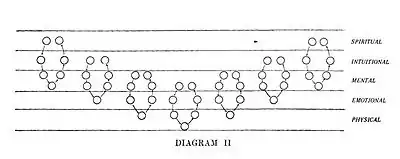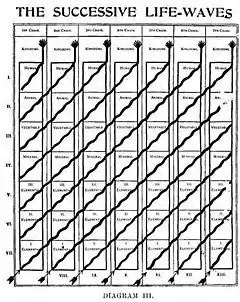Man: Whence, How and Whither, a Record of Clairvoyant Investigation
Man: Whence, How and Whither, A Record of Clairvoyant Investigation, published in 1913, is a theosophical book compiled by the second president of the Theosophical Society (TS) - Adyar, Annie Besant, and by a TS member, Charles W. Leadbeater.[note 1] The book is a study on early times on planetary chains, beginnings of early root races, early civilizations and empires, and past lives of men.[2][note 2]
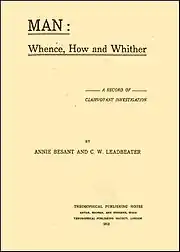 Title page to the first edition, 1913 | |
| Authors | A. Besant, C. W. Leadbeater |
|---|---|
| Country | British India |
| Language | English |
| Subject | Theosophy |
| Publisher | Theosophical Publishing House |
Publication date | 1913 (1st edition) |
| Pages | 524 |
| OCLC | 871602 |
| Text | Man: Whence, How and Whither online |
Introduction
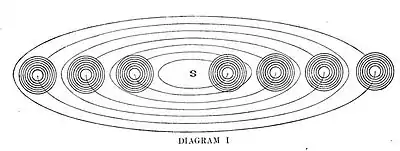
At the beginning of the book the authors wrote that "metaphysicians, ancient and modern, declare that Past, Present, and Future are ever simultaneously existent in the divine Consciousness, and are only successive as they come into manifestation, i.e., under Time which is verily the succession of states of consciousness." Hence, when a mystic turns the soul away from earth and focuses his attention upon the spirit – the soul may approach the "Memory of Nature", the personification in the material world of the "Thoughts of the Logos," the image, as it were, of "His Mind." There resides the Past in ever-living records.[5][6][7][8][9][10]
The authors say that "they, having been taught the method of gaining touch, but being subject to the difficulties involved in their uncompleted evolution, have done their best to observe and transmit, but are fully conscious of the many weaknesses which mar their work. Occasional help has been given to them by the Elder Brethren."[11]
Explorations of past lives
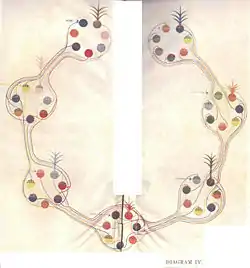
Leadbeater speculated that "the total number of souls, or Monads,[13] making up humanity was sixty thousand million, the majority being out of incarnation at any given time."[14] Thus reincarnation[15][13] had been one of the doctrines of the Theosophical Society almost from its beginnings. The principal characters (so-called "star names" or pseudonyms) are identified in the following table.[note 4][note 5]
- Alcyone — Krishnamurti.[19][note 6]
- Fides — G. Arundale.
- Herakles — Besant.[19][note 7]
- Lomia — Wedgwood.
- Phocea — Judge.
- Polaris — Wadia.
- Selene — Jinarajadasa.
- Sirius — Leadbeater.[19][note 8]
- Siwa — Subba Row.[25]
- Spica — F. Arundale.
- Ulysses — Olcott.[25][note 9]
- Vajra — Blavatsky.[25][note 10]
Leadbeater wrote later that "the two hundred and fifty characters to whom names have been assigned are supposed to be less than one tenth of the whole".[27] Professor Joscelyn Godwin said, "The series of incarnations showed these pioneers going through their own evolution from subhumans to worldly and spiritual leaders of the race."[25]
Early root races
In Lemuria
In the chapter VII the authors describe in detail[note 11] a remarkable Lemurian:
"In Lemuria there was some domestication of animals; the egg-headed Lemurian[note 12] was seen leading about a scaly monster, almost as unattractive as his master. Animals of all sorts were eaten raw – among some tribes human flesh was not despised – and creatures of the grade of our slugs, snails and worms, much larger than their degenerate descendants, were regarded with peculiar favor as toothsome morsels."[30][note 13]
In Atlantis
In the chapter IX the authors wrote about Atlantis that "explosions of gas, floods and earthquakes" razed Ruta and Daitya, the great islands, left from the cataclysm of 200,000 B.C., and only the island of Poseidonis remained, the last vestige of the once grand continent of the Atlantis. These islands were lost in 75,025 B.C., Poseidonis survived to 9,564 B.C., when it also was devoured by the ocean.[32]
The authors assert in the chapter X of the book:
"The immense growth of wealth and of luxury gradually undermined the most splendid civilization that the world has yet seen. Knowledge was prostituted to individual gain, and control over the powers of nature was turned from service to oppression. Hence Atlantis fell, despite the glory of its achievements and the might of its Empires."[33][note 14]
On the Moon chain
Blavatsky wrote in The Secret Doctrine that the Moon "plays the largest and most important part, as well in the formation of the Earth itself, as in the peopling thereof with human beings". The "Lunar Monads" or Pitris, the progenitors of man, become in reality man himself.[37] A religious studies scholar Isaac Lubelsky stated that Besant and Leadbeater write in the book the chain of the Moon "was an evolutionary precursor of the chain of the planet Earth."[2]
In the chapter III the authors describe in detail how Sirius, Alcyone, Herakles and Mizar[note 15] achieved individualization[note 16] and left the animal kingdom while living as lunar monkey-creatures.[note 17] They were servants to a family of lunar men, the leaders of which are now the Masters M. and K.H.[note 18] Leadbeater wrote that "individualization from the animal kingdom usually takes place through association with the humanity of the period. Such examples of it as we occasionally see taking place round us at the present time will serve as instances for us." Some peculiar domestic animal, well treated by its human friends, is stimulated by its permanent contact with them up to the point where it breaks away from the group-soul to which it has previously belonged.[40] The authors wrote:
"One night there is an alarm; the hut is surrounded by savages, supported by their domesticated animals, fierce and strong, resembling furry lizards and crocodiles. The faithful guardians spring up around their master's hut and fight desperately in its defence; Mars comes out and drives back the assailants, using some weapons they do not possess; but, while he drives them backward, a lizard-like creature darts behind him into the hut, and catching up the child Surya[note 19] begins to carry him away. Sirius springs at him, bearing him down, and throws the child to Alcyone, who carries him back into the hut, while Sirius grapples with the lizard, and, after a desperate struggle, kills it, falling senseless, badly mangled, over its body. Meanwhile, a savage slips behind Mars and stabs at his back, but Herakles, with one leap, flings himself between his master and the weapon and receives the blow full on his breast, and falls, dying. The savages are now flying in all directions, and Mars, feeling the fall of some creature against his back, staggers, and, recovering himself, turns. He recognizes his faithful animal defender, bends over his dying servant, and places his head in his lap. The poor monkey lifts his eyes, full of intense devotion, to his master's face, and the act of service done, with passionate desire to save, calls down a stream of response from the Will aspect of the Monad in a fierce rush of power, and in the very moment of dying the monkey individualizes, and thus he dies – a man."[41]
Fruits of Evolution
The theosophical concept of Evolution suppose spiritual development of the Mankind will attain the fullness of the stature of Buddha, Christ, etc. of the prize of the high calling of God in Christianity.[44][13]
The authors the book proclaimed "when the Human Kingdom is traversed, and man stands on the threshold of His superhuman life, a liberated Spirit", seven paths open before Him for His choosing: He may enter into the blissful omniscience and omnipotence of Nirvana, with activities far beyond our knowing, to become, perchance, in some future world an Avatara, or godlike Incarnation; this is sometimes called, "taking the Dharmakaya vesture". He may enter on "the Spiritual Period" — a phrase including unknown meanings, among them probably that of "taking the Sambhogakaya vesture". He may become part of that treasure-house of spiritual forces on which the Agents of the Logos draw for Their work, "taking the Nirmanakaya vesture". He may remain a member of the Occult Hierarchy which rules and guards the world in which He has reached perfection. He may pass on to the next Chain, to aid in constructing its forms. He may enter the majestic Angel – Deva-Evolution. He may give Himself to the immediate service of the Logos, to be used by Him in any part of the Solar System, His Servant and Messenger, who lives but to carry out His will and do His work over the whole of the system which He controls.[45]
Criticism
A religious studies scholar Alvin Kuhn wrote in his thesis that The Canadian Theosophist, a magazine published at Toronto, announced a series of articles in which "parallel passages from the writings of Mrs. Blavatsky and the Mahatma Letters on one side, and from the books of Mrs. Besant and Mr. Leadbeater, on the other (Man: whence, how and whither included), gave specific evidence bearing on the claims of perversion of the original theories by those whom they call Neo-Theosophists."[46][note 21]
John Prentice in an article Clairvoyant Research criticized the book of the authors. He proclaimed that the material for the Peruvian lives in Man: whence, how and whither (Ch. XI) had been lifted out of Garcilaso de la Vega's Royal Commentaries on the Yuccas of Peru (written in 1609 and published in English translation in 1638, 1869 and 1871).[48]
Joseph Fussell wrote about "abnormal and preposterous claims" published by Besant and Leadbeater.[49][50]
Helena Roerich stated that Leadbeater's books are a mix of "false and ugly" statements and some fragments of truth: one of the Great Masters supposedly called the book Man: Whence, How and Whither as "a work which devoid of knowledge, honesty and beauty."[51] She wrote: "The book by Besant and Leadbeater is particularly awful, therein is described the lives supposedly the Great Masters and some their pupils, namely: Besant, Leadbeater... I've never seen anything equal to this tasteless blasphemy and falsehood."[52]
Professor Olav Hammer stated that Leadbeater's claims about past lives "were increasingly used to buttress power struggles." He wrote, "Those who supported the controversial Leadbeater were recorded as having had important roles in the past, while his opponents were depicted as villains." [53] In his thesis Hammer wrote:
"How can Leadbeater's readers know that his clairvoyant results really are 'records' and 'information', rather than delusions or deliberate fabrications? His response is feeble, 'there is no assurance. The investigators themselves are certain <...> of the difference between observation and imagination'."[54]
Alice Bailey stated that the book published at Adyar by Besant and Leadbeater was "psychic in his implications and impossible of verification". In her Unfinished Autobiography she wrote that it proved to her the "untrustworthiness" of Leadbeater's writings:
"Books were being published at Adyar by Mr. Leadbeater that were psychic in their implications and impossible of verification, carrying a strong note of astralism. One of his major works, Man: Whence, How and Whither, was a book that proved to me the basic untrustworthiness of what he wrote. It is a book that outlines the future and the work of the Hierarchy of the future, and the curious and arresting thing to me was that the majority of the people slated to hold high office in the Hierarchy and in the future coming civilisation were all Mr. Leadbeater's personal friends. I knew some of these people—worthy, kind, and mediocre, none of them intellectual giants and most of them completely unimportant."[55]
Publications
- Man: Whence, How and Whither. Adyar: Theosophical Publishing House. 1913. OCLC 871602.
- Man: Whence, How and Whither (3rd ed.). Adyar: Theosophical Publishing House. 1954 [1913]. OCLC 600704822.
- Man: Whence, How and Whither (5th reprint, slightly abridged ed.). Adyar: Theosophical Publishing House. 1971 [1913]. OCLC 730293084.
- Man: Whence, How and Whither (Online ed.). Altenmünster Jazzybee Verlag. 2013 [1913]. ISBN 9783849641832. OCLC 867192162.
See also
Notes
- According to WorldCat, "18 editions published between 1913 and 1984 in English and held by 177 WorldCat member libraries worldwide."[1]
- There were other collaborative authors clairvoyant works, Occult Chemistry (1908) and The Lives of Alcyone (1924).[3]
- "At any one period of time only one of the rings in each Scheme will be active; each ring of each of these seven Schemes is composed of seven globes."[4]
- Drawn from the lists in the book.[16]
- Leadbeater talked in The Inner Life that "about a hundred and fifty of those who are at present members of the Theosophical Society are the prominent characters in the drama which lies before the readers of The Theosophist."[17][18]
- Kuhn wrote that Alcyone is Krishnamurti's "true or cosmic name."[20]
- Jinarajadasa claimed that Besant was Bruno;[21] Senkevich wrote that Besant was Bruno, and Bruno earlier was Hipatia.[22] Alone Roerich claimed: "Giordano Bruno has been the incarnation of the Gr.[eat] Mas.[ter] Hilarion. But... theosophists falsely have ascribed this incarnation to An.[nie] Besant."[23]
- Jinarajadasa claimed that, "Mr. Leadbeater knew the details of his incarnation as a Greek in Athens."[24]
- About Olcott's past life see in the chapter XXII.[26]
- About Blavatsky's past life see The Hidden Life in Freemasonry by C.W. Leadbeater.
- "Leadbeater wrote elaborate descriptions of these things in a style of simplicity and clearness," — claimed Kuhn.[28]
- Blavatsky stated that the Lemurian is "the first physical man which itself took place 18,000,000 years ago."[29]
- Professor Joscelyn Godwin wrote, "Leadbeater regularly adopts an archly humorous tone when dealing with disgusting habits, ugly people, or lowly human types."[31]
- Blavatsky claimed, "The civilization of the Atlanteans was greater even than that of the Egyptians. It is their degenerate descendants, the nation of Plato's Atlantis, which built the first Pyramids... The great Pyramid must have been built 78,000 years ago."[34]
- Mizar — J. Nityananda (drawn from the lists in the book).[16]
- "The divine life begins the evolution of consciousness, building for itself forms on the various planes, passing slowly through the elemental, mineral, vegetable, and animal kingdoms, and finally reaching self-consciousness and individualization, when it passes into the human stage."[38]
- The lunar manvantara generated seven classes of the entities for the earthly manvantara.[39]
- M. — Mars, K.H. — Mercury (drawn from the lists in the book).[16][25]
- "Surya — the Lord Maitreya, the present Bodhisattva, the Supreme Teacher of the world" (drawn from the lists in the book).[16]
- "The vertical columns indicate the successive incarnations of the Chain; the horizontal divisions represent the various kingdoms of nature; the diagonal arrows are the successive waves of Evolution which have come forth from the Logos."[43]
- Thomas stated, "Many, many have doubtless been turned away from genuine Theosophy after being exposed to the obvious gibberish of 'Leadbeaterism' and not being aware of the difference."[47]
References
- WorldCat.
- Lubelsky 2013, p. 351.
- Tillett 1986, p. 1013.
- Besant, Leadbeater 1913, p. 4.
- Besant, Leadbeater 1913, pp. iv–v.
- Cayce 1968.
- Tillett 1986, p. 985.
- Cerminara 1988.
- Todeschi 1998.
- Ramacharaka 2007, pp. 106–7.
- Besant, Leadbeater 1913, p. v.
- Besant, Leadbeater 1913, p. 9.
- Трефилов 1994, p. 236.
- Tillett 1986, p. 1010.
- Fussell, Poutz 1911, p. 408.
- Besant, Leadbeater 1913, Foreword.
- Leadbeater 1912, Sect. 4/4.
- Wood 1947.
- Hammer 2003, p. 474.
- Kuhn 1992, p. 334.
- Jinarajadasa 2003.
- Сенкевич 2012, p. 459.
- Рерих 1993, p. 332.
- Jinarajadasa 2013, p. 44.
- Godwin 2011, Ch. 4.
- Besant, Leadbeater 1913, p. 341.
- Besant, Leadbeater 1924, Foreword.
- Kuhn 1992, p. 329.
- Blavatsky 1888b, p. 46; Lubelsky 2013, p. 345.
- Besant, Leadbeater 1913, p. 105; Tillett 1986, p. 452.
- Godwin 2011, p. 99.
- Besant, Leadbeater 1913, p. 132; Lubelsky 2013, p. 351.
- Besant, Leadbeater 1913, p. 139.
- Blavatsky 1888b, pp. 429, 432; Lubelsky 2013, p. 345.
- Besant, Leadbeater 1913, p. 5.
- Трефилов 1994, p. 237.
- Blavatsky 1888a, p. 180.
- Fussell, Poutz 1911, p. 407.
- Трефилов 1994, p. 235.
- Leadbeater 1912, Sect. 6/6.
- Besant, Leadbeater 1913, pp. 35–6; Tillett 1986, pp. 450–51.
- Besant, Leadbeater 1913, p. 7.
- Leadbeater 1912, Sect. 6/3.
- Sellon, Weber 1992, p. 324.
- Besant, Leadbeater 1913, p. 12.
- Kuhn 1992, p. 330.
- Thomas.
- Prentice 1923.
- Fussell 1914.
- Tillett 1986, pp. 630–31.
- Рерих 2001.
- Рерих 1993, p. 45.
- Washington 1995, p. 129; Hammer 2003, p. 474.
- Besant, Leadbeater 1913, p. 485; Hammer 2003, p. 474.
- Bailey 2013, Ch. IV.
Sources
- "Leadbeater, Charles Webster 1854–1934". OCLC WorldCat. Retrieved 2018-11-02.
- Bailey, A. (2013) [1951]. The Unfinished Autobiography. London: Lucis Press Ltd. ISBN 978-0853300243. Retrieved 14 February 2017.
- Besant, A.; Leadbeater, C. W. (1924). The Lives of Alcyone. Adyar: Theosophical Publishing House.
- Blavatsky, H. P. (1888a). The Secret Doctrine (PDF). Vol. 1. London: Theosophical Publishing Company. Retrieved 14 February 2017.
- ———— (1888b). The Secret Doctrine (PDF). Vol. 2. London: Theosophical Publishing Company. Retrieved 14 February 2017.
- Cayce, E. E. (1968). Cayce, H. L. (ed.). Edgar Cayce on Atlantis. Edgar Cayce Series. New York: Warner Books. ISBN 9780446351027. Retrieved 14 February 2017.
- Cerminara, G. (1988). Many mansions: the Edgar Cayce Story on Reincarnation. New York: Signet. ISBN 9780451168177. Retrieved 14 February 2017.
- Fussell, J. H.; Poutz, M. (1911). "Theosophy". In Jackson, S. (ed.). The New Schaff-Herzog Encyclopedia of Religious Knowledge. Vol. 11. New York: Funk and Wagnalls. pp. 407–10. Retrieved 14 February 2017.
- Fussell, Joseph (1914). Some Reasons Why the Members of the Universal Brotherhood and Theosophical Society Do Not Endorse Mrs. Besant Nor the Society of Which She is President. San Diego: San Diego News Press. OCLC 314747682.
- Godwin, J. (2011). Atlantis and the Cycles of Time: Prophecies, Traditions, and Occult Revelations. Rochester, Vt: Inner Traditions. ISBN 978-1-59477-857-5. Retrieved 14 February 2017.
- Hammer, O. (2003) [2001]. Claiming Knowledge: Strategies of Epistemology from Theosophy to the New Age (PhD thesis). Studies in the history of religions. Boston: Brill. ISBN 9789004136380. Retrieved 31 October 2018.
- Jinarajadasa, C. (2003) [1938]. Occult investigations, a description of the work of Annie Besant and C.W. Leadbeater. Whitefish, MT: Kessinger Publishing. ISBN 0766130347. Retrieved 14 February 2017.
- ———— (2013) [1941]. The K. H. Letters to C. W. Leadbeater. Literary Licensing, LLC. ISBN 9781258882549. Retrieved 14 February 2017.
- Kuhn, A. B. (1992) [1930]. Theosophy: A Modern Revival of Ancient Wisdom (PhD thesis). American religion series: Studies in religion and culture. Whitefish, MT: Kessinger Publishing. ISBN 978-1-56459-175-3. Retrieved 14 February 2017.
- Leadbeater, C. W. (1912) [1910]. The Inner Life. Vol. 2 (2nd ed.). Chicago: The Rajput Press. OCLC 872469277. Retrieved 14 February 2017.
- Lubelsky, Isaac (2013). "Mythological and Real Race Issues in Theosophy". In Hammer, O.; Rothstein, M. (eds.). Handbook of the Theosophical Current. Brill Handbooks on Contemporary Religion. Boston: Brill. pp. 335–356. ISBN 9789004235960. Retrieved 3 November 2018.
- Prentice, John (1 November 1923). "Clairvoyant Research". Dawn. Sydney.
- Ramacharaka, Yogi (2007) [1903]. Fourteen lessons in Yogi philosophy. New York: Cosimo, Inc. ISBN 9781605200361. Retrieved 14 February 2017.
- Sellon, E. B.; Weber, R. (1992). "Theosophy and The Theosophical Society". In Faivre, A.; Needleman, J. (eds.). Modern esoteric spirituality. World spirituality. New York: Crossroad. pp. 311–29. ISBN 0-8245-1145-X. Archived from the original on 26 October 2014. Retrieved 14 February 2017.
- Thomas, Margaret (2003). Jaqua, M. R. (ed.). "Theosophy versus Neotheosophy: Study of C.W. Leadbeater's and Annie Besant's Theosophical Teachings". blavatskyarchives.com. Retrieved 14 February 2017.
- Tillett, Gregory J. (1986). Charles Webster Leadbeater 1854–1934: a biographical study (PhD thesis). Sydney: University of Sydney (published 2007). hdl:2123/1623. OCLC 220306221. Retrieved 14 February 2017 – via Sydney Digital Theses.

- Todeschi, K. J. (1998). Edgar Cayce on the Akashic Records. Virginia Beach, Va: A.R.E. Press. ISBN 978-0-87604-401-8. Retrieved 14 February 2017.
- Washington, P. (1995). Madame Blavatsky's baboon: a history of the mystics, mediums, and misfits who brought spiritualism to America. Schocken Books. ISBN 9780805241259. Retrieved 31 October 2018.
- Wood, E. E. (1947). Jinarajadasa, C. (ed.). Clairvoyant investigations by C.W. Leadbeater and "The lives of Alcyone" (J. Krishnamurti). Adyar: Theosophical Publishing House. Retrieved 14 February 2017.
- Рерих, Е. И. (1993). Письма Елены Рерих [Helena Roerich Letters] (in Russian). Вико. ISBN 9785860590106. Retrieved 14 February 2017.
- ———— (2001). "Письмо В.М. Сеплевенко, 4 ноября 1935 года" [The Letter to V.M. Seplevenko, 4 November 1935]. Письма. Том III [Letters. Volume III] (in Russian). Москва: Международный Центр Рерихов. Retrieved 14 February 2017.
- Сенкевич, А. Н. (2012). Елена Блаватская. Между светом и тьмой [Helena Blavatsky. Between Light and Darkness]. Носители тайных знаний (in Russian). Москва: Алгоритм. ISBN 978-5-4438-0237-4. OCLC 852503157. Retrieved 14 February 2017.
- Трефилов, В. А. (1994). "Глава XVII: Надконфессиональная синкретическая религиозная философия" [Chapter XVII: Non-denominational syncretic religious philosophy]. In Яблоков, Игорь (ed.). Основы религиоведения. Учебник [Fundamentals of Religious Studies. Textbook] (in Russian). Москва: Высшая школа. pp. 233–245. ISBN 5-06-002849-6. Retrieved 14 February 2017.
External links
- Man: Whence, How and Whither hosted at Archive.org
- Man: Whence, How and Whither
- Man: Whence, How and Whither
- Translations
